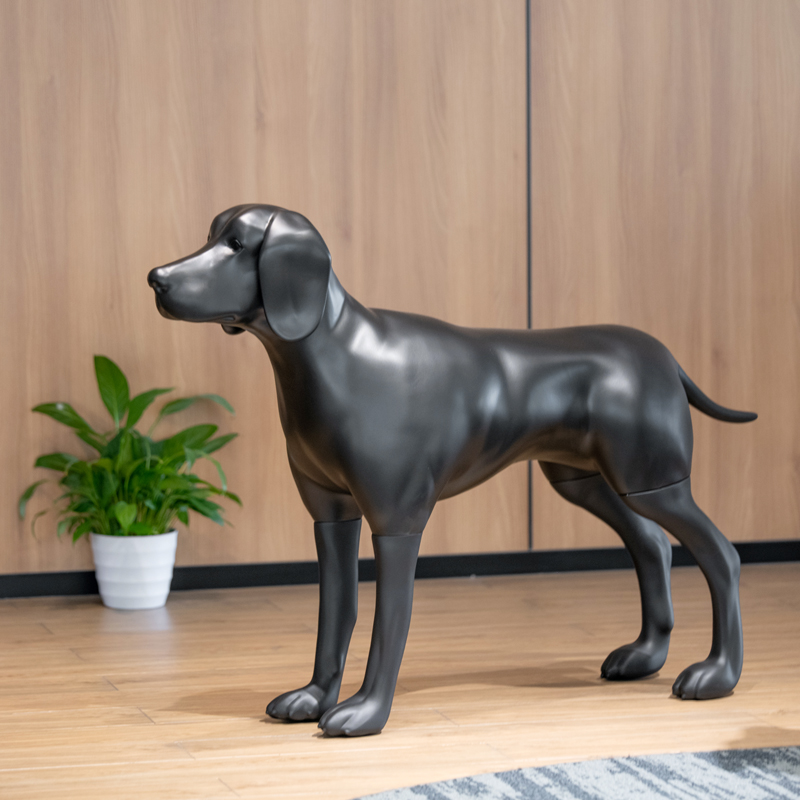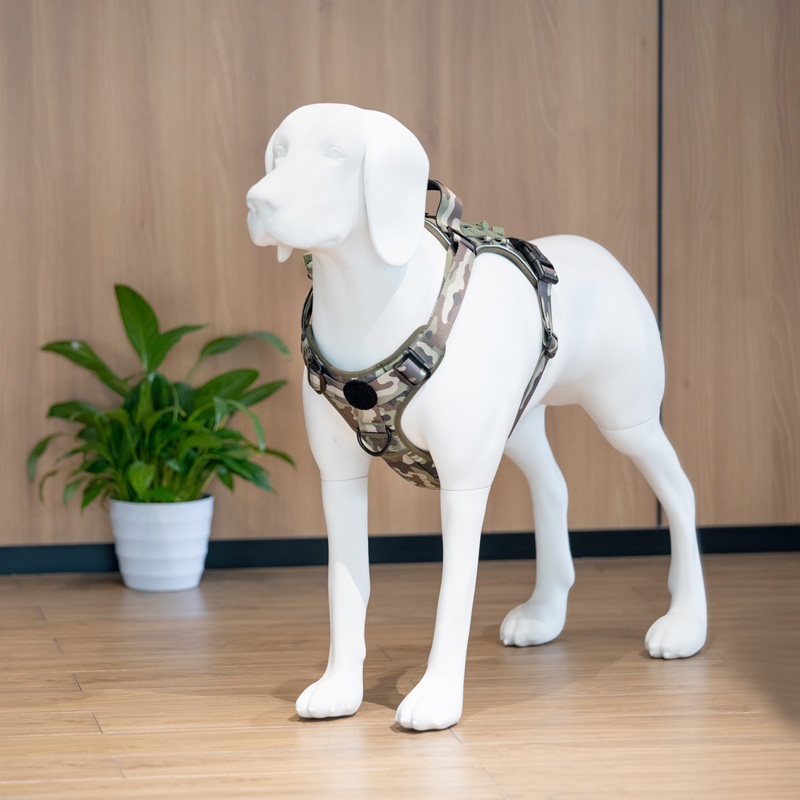Looking for the perfect way to display your dog apparel? Choosing the right dog mannequin can significantly enhance your product presentation. The material of your dog mannequin model impacts how customers perceive the fit and quality of your clothes.
In this post, we’ll discuss the best materials for dog clothing mannequins and how each option can elevate your store's display. You’ll learn about fiberglass, plastic, and wood mannequins and their benefits.
Why Choosing the Right Material Matters for Dog Clothing Mannequins
What are Dog Clothing Mannequins?
A dog mannequin display is a life-sized or scaled model used to showcase dog clothing. These mannequins allow customers to see how clothes fit and look on a dog. They come in various shapes and sizes, offering a realistic representation of how the apparel would appear in real life.
Whether you sell casual wear, coats, or accessories, a mannequin for dog clothes can highlight the design and functionality of your products. A good mannequin can make a huge difference in customer perception and sales.
How Can the Right Material Improve Your Dog Mannequin Display?
The material of a pet mannequin plays a crucial role in how your products are perceived. Here’s how different materials can affect your display:
Durability: Some materials, like fiberglass, are highly durable, ensuring long-lasting displays. Plastic mannequins are also durable but are more prone to wear and tear over time.
Ease of Maintenance: Mannequins made of plastic and fiberglass are easier to clean, needing only a simple wipe-down. Wooden mannequins require more care to prevent scratches and damage.
Realistic Appearance: Pet display mannequins made from fiberglass tend to have the most realistic look, mimicking the human form closely. Plastic mannequins may lack fine details but still offer a clean look for everyday displays.
The material choice can also impact how flexible your displays are. A mannequin that can easily hold different poses or be customized can help keep your store's displays fresh and dynamic.

Popular Materials for Dog Clothing Mannequins
Fiberglass Mannequins
Pros:
Highly durable: Fiberglass mannequins are tough and can withstand wear and tear.
Realistic appearance: They provide a lifelike display of your dog apparel, making clothes look more appealing.
Customizable: These mannequins can be adjusted into different poses, giving you more flexibility with your displays.
Cons:
More fragile: Though durable, fiberglass can crack or chip if dropped or mishandled.
Higher initial cost: Fiberglass mannequins are generally more expensive than plastic options.
When to Choose Fiberglass:
Opt for fiberglass if you're displaying high-end dog apparel or need a mannequin that looks as realistic as possible. These mannequins work best in boutique stores or high-end environments.
Plastic Mannequins
Pros:
Cost-effective: Plastic mannequins are typically much cheaper than fiberglass.
Lightweight: They are easy to move around and adjust in your store displays.
Versatile in design: Plastic mannequins come in many shapes and poses.
Cons:
Less realistic: While they can resemble the human form, they don't offer the same fine details as fiberglass.
Can yellow over time: Lower-quality plastic mannequins may discolor, especially with exposure to light.
When to Choose Plastic:
Plastic is perfect for budget-conscious businesses or stores that regularly change their displays. It's also a great option for temporary setups or events.
Wooden Mannequins
Pros:
Eco-friendly: Wood is a renewable resource, making it a more sustainable choice.
Unique aesthetic: Wooden mannequins provide a natural, rustic look, ideal for eco-conscious or boutique brands.
Durable: When well-maintained, wooden mannequins can last a long time.
Cons:
Heavier: Wood mannequins are typically heavier, which can make them more difficult to move.
More maintenance: They require periodic care to prevent scratches and damage.
Less flexible in posing: Unlike plastic or fiberglass, wooden mannequins are often fixed in a single pose.
When to Choose Wooden:
Choose wooden mannequins if you want to showcase artisan dog apparel or have a boutique store focused on sustainability and unique designs.
How to Choose the Best Material Based on Dog Size and Clothing Type
Mannequins for Large Dog Breeds (e.g., Weimaraner Mannequins)
What to Consider:
When choosing a large dog mannequin, focus on materials that can support the structure of bigger breeds. These mannequins need to be strong and sturdy, as larger dogs tend to have a more robust frame. Fiberglass mannequins are often the best option due to their durability and realistic appearance. They can be customized to fit the size of breeds like the Weimaraner.
For these larger breeds, it’s important to ensure the mannequin can hold the clothing securely, allowing customers to visualize the fit. The right material will help create a professional, appealing display.
Mannequins for Small Dogs
What to Consider:
For smaller dogs, choose lightweight mannequins that are easy to handle and move around. Plastic mannequins work well here because they are easy to adjust and won’t be too heavy to shift around when necessary. Customizable mannequins are great for small dog clothing, as they allow you to modify the mannequin to fit the style of each outfit.
Small dog mannequins need to reflect the daintiness of smaller breeds, so choosing a material that maintains the shape and structure of delicate clothes is key.
Materials for Dynamic Posing and Displaying Active Dog Clothes
Ideal Materials:
If you sell active dog clothes, such as jackets for outdoor adventures or agility wear, you’ll need mannequins that can hold multiple poses. Plastic and fiberglass are ideal for this purpose. These materials are versatile and can support dynamic poses that help showcase the flexibility of active wear.
When displaying clothes meant for movement, having a mannequin that can bend or twist into different positions will give your store a lively, engaging feel. This helps customers visualize how the clothing would perform during physical activities.

What Are the Advantages of Realistic Dog Mannequins?
How Realistic Mannequins Enhance the Shopping Experience
Explanation:
The more realistic the dog mannequin display, the easier it is for customers to visualize how the clothing will look on their own pets. A lifelike mannequin helps create a connection between the product and the customer. It shows the fit, texture, and overall look of the clothing in a way that flat images or basic models can’t.
When customers see a mannequin dog dressed in a detailed outfit, they can better imagine their dog in the same clothes. This helps them make purchasing decisions more easily.
Are Canine Mannequins Worth the Investment?
Long-term Benefits:
While canine mannequins might come with a higher initial cost, they offer great long-term value. These mannequins are durable, often lasting for years if maintained properly. They also attract attention, making your displays more eye-catching and professional.
Realistic mannequins are particularly effective at showcasing premium dog apparel. They bring the clothing to life and help convey the quality of the product. Customers are more likely to trust and invest in high-quality products when they can see them displayed on a well-crafted, realistic mannequin.
How to Maintain and Care for Your Dog Mannequin Display
General Care Tips for Dog Mannequins
Taking care of your dog mannequin model is essential to keep it looking fresh and functional. Regular dusting and cleaning prevent dirt and debris from building up. It’s also a good idea to use protective measures, like covering the mannequin when not in use, to extend its lifespan.
For pet display mannequins, regular maintenance can make a big difference in the appearance and durability of your mannequins, especially in high-traffic areas like stores or showrooms.
Specific Maintenance for Different Materials
Fiberglass:
Fiberglass mannequins require occasional buffing to remove chips or cracks. These mannequins can be sensitive to impacts, so always handle them carefully. If you notice any damage, buff it out gently and apply a protective coating for extra durability.
Plastic:
Plastic mannequins are easier to maintain. Simply wipe them down using a damp cloth to remove dust and prevent yellowing. Be cautious when cleaning, as rough materials can scratch the surface.
Wood:
Wooden mannequins need special attention to preserve their look. Regularly clean and polish the wood to prevent wear. Wood can be sensitive to moisture, so avoid using harsh cleaning products or exposing the mannequin to high humidity.
Cost Considerations for Dog Clothing Mannequins
Are Pet Display Mannequins Expensive?
Price Comparison:
The cost of pet display mannequins can vary greatly depending on the material.
Fiberglass: Typically the most expensive option due to its realistic appearance and durability. Expect to pay more for these high-quality mannequins.
Plastic: More affordable and budget-friendly, making them ideal for businesses on a tighter budget. Plastic mannequins can still provide good display value but lack the realism of fiberglass.
Wood: Wooden mannequins can be more expensive than plastic but are often less costly than fiberglass. Their price depends on the quality of the wood and any customization.
For businesses looking to balance quality and cost, plastic mannequins are a practical choice, while fiberglass mannequins provide the most premium option.
How to Get the Best Value for Your Budget
Suggestions:
When making a purchasing decision for dog mannequin models, it’s essential to think about longevity and the purpose of your displays.
Longevity: Choose materials like fiberglass or wood if you plan to use the mannequins for years. They may cost more upfront but will save you money in the long run.
Purpose of Displays: If your mannequins will be used for seasonal displays or temporary events, plastic mannequins can be a cost-effective choice.
Customization: Consider whether you need customizable mannequins. Customization options may add to the initial cost but can make your displays more unique and appealing.
Investing in the right mannequin will give you better returns, especially if it matches the type of dog apparel you sell.
Conclusion
When selecting the best dog clothing mannequins, consider materials like fiberglass, plastic, and wood. Each material offers unique benefits in terms of durability, realism, and cost.
Always choose a material that matches your store's style, budget, and the types of dog apparel you showcase.
Ready to upgrade your display? Explore our collection of dog mannequins to elevate your pet apparel presentations. SunRayMascota leads the pet product display market, offering high-quality products and services. Contact us for a customized solution!
FAQs
Q: What are the different types of materials used for dog clothing mannequins?
A: The most common materials for dog mannequins are fiberglass, plastic, and wood. Each material offers unique benefits: fiberglass is durable and realistic, plastic is cost-effective and lightweight, while wood provides an eco-friendly, rustic charm.
Q: Can I use a plastic dog mannequin for showcasing high-end dog apparel?
A: Plastic dog mannequins are affordable and versatile but lack the realism of fiberglass. They are best for budget-friendly or temporary displays.
Q: Are wooden mannequins a good choice for dog clothing displays?
A: Wooden mannequins are ideal for unique, eco-friendly displays, adding rustic charm. However, they require more maintenance and are heavier than other options.
Q: How long do dog mannequins typically last?
A: Fiberglass mannequins last many years, plastic mannequins last a few years, and wooden mannequins last long if maintained properly but may scratch more easily.
Q: Are dog mannequins eco-friendly?
A: Wooden mannequins are eco-friendly since wood is renewable. Fiberglass and plastic mannequins can have a higher environmental impact due to their production processes.

















